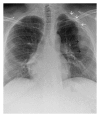A unique case of left second supernumerary and left third bifid intrathoracic ribs with block vertebrae and hypoplastic left lung
- PMID: 24416613
- PMCID: PMC3876714
- DOI: 10.1155/2013/620120
A unique case of left second supernumerary and left third bifid intrathoracic ribs with block vertebrae and hypoplastic left lung
Abstract
Intrathoracic rib (IR) is a very rare anomaly in which a normal, an accessory, or a bifid rib lies within the chest cavity and may originate from a vertebra or a rib. It is more commonly present on the right side, and sometimes it may be associated with vertebral anomalies. Only 50 cases have been reported to date in the literature. In most cases, the IR is an isolated finding; it is incidentally detected and is asymptomatic. The IR can be easily missed on a chest radiograph and can be mistaken initially for a pleural lesion, lung consolidation, other peripheral lung parenchymal lesions, or a bony lesion. It is, therefore, essential for physicians and radiologists to know about this entity and consider it in the differential diagnosis, to avoid further evaluation and unnecessary investigations. We present a unique case of three intrathoracic ribs, a left second supernumerary rib, left third depressed normonumerary rib, and bifid arm of the left third rib, with block vertebrae and hypoplastic left lung. To our knowledge, this is the first such case presentation in the published literature.
Figures





References
-
- Bottosso N, Ghaye B. Bifid intrathoracic rib. Journal Belge de Radiologie. 2008;91(3):86–87. - PubMed
-
- Kayiran SM, Gumus T, Kayiran PG, Gurakan B. Supernumerary intrathoracic rib. Archives of Disease in Childhood. 2013;98(6, article 441) - PubMed
-
- Chung JH, Pipavath SN. Images in clinical medicine. Intrathoracic rib. New England Journal of Medicine. 2009;361(26, article 2557) - PubMed
-
- Apaydin M, Sarsilmaz A, Varer M. Third accessory (supernumerary) intrathoracic right rib. Surgical and Radiologic Anatomy. 2009;31(8):641–643. - PubMed
LinkOut - more resources
Full Text Sources
Other Literature Sources

